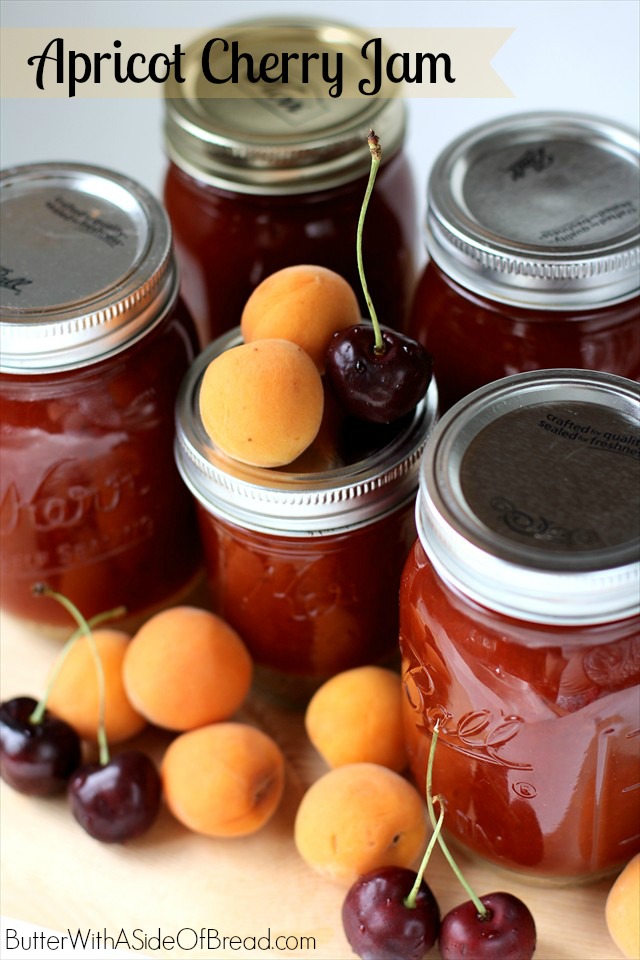
Isn't homemade jam the best? Our family very rarely purchases jam at the store because I just love making it and we always seem to have a variety on hand. I knew I wanted to make some jam when a friend gave us a ton of apricots, but I wanted to put a twist on it. Apricots have a very, very mild flavor so pairing them with something more bold, like fresh cherries, took the jam to a whole new level. It's delicious and I'm excited to have it on muffins and biscuits all winter long!
I like to use the low/ no sugar pectin when making jam. It generally requires several cups less of sugar and allows you to taste the fruit more, instead of the mixture just being super sweet.
I use the "Inversion Method" of canning jam. Because it's done without using a boiling water-bath process, there is a small risk of your jam spoiling prior to you eating it. I generally only invert the jams we plan to use within 6-8 month's time. That being said I've used this method for years and years with hundreds of jars of jam and I've never had a single jar spoil. However, to each his own- if you have the time/ energy/ equipment to water bath can the jam, by all means, do that!
Apricot Cherry Jam
Adapted from Sure-Jell's Less Sugar Apricot Jam recipe, found inside my box of pectin
- 5 cups pureed apricots (buy about 3 lbs. fully ripe apricots)
- 1 cup pureed cherries {buy about 2- 2 1/2 cups fruit}
- 2 Tbsp. fresh lemon juice
- 1 tsp. EVER-FRESH Fruit Protector
- 4-1/2 cups sugar, measured into a bowl {you'll need to divide it somewhat later on}
- 1 box SURE-JELL For Less or No Sugar Needed Recipes Premium Fruit Pectin
- 1/2 tsp. butter
You can see my set-up below. I use one of those basic, cheap food processors for recipes like this. It does the job well and I have less dishes to wash than when I use my big food processor.
Next you'll want to do the same process for the cherries. Wash them, then halve them, removing the cherry pit in the process. For 1 cup puree, you'll generally use about 2- 2 1/2 cups fruit. Puree the cherries more than you did the apricots- the cherries will be more "baby food" like.
Pour fruit into a large stockpot. Stir in lemon juice and fruit protector. Turn heat on medium-high and put a lid on the mixture. Allow it to heat up for about 10 minutes, stirring about once every 2-3 minutes.
At this point the jam is more orange than red. Don't worry- as it cooks those little bits of cherry skin will disappear and the jam will turn a beautiful red color.
Mix 1/4 cup of the sugar (from the measured amount in the bowl) and pectin in small bowl. Add to fruit in stockpot. Add butter to reduce foaming. Bring mixture to full rolling boil (a boil that doesn't stop bubbling when stirred) on high heat, stirring constantly.
Stir in remaining 4-1/4 cups sugar. Return to full rolling boil and boil for about 5-10 minutes. After about 5 minutes I take a small spoonful and put it in a little bowl, then put both in the freezer. After a minute or two that small jam sample has cooled and you can see if your jam will set up. If the mixture cools and it's very runny, add about 1/4 cup more sugar and boil an additional 5 minutes, stirring constantly. If the sample of jam sets up into a nice jam texture, it's done!
Remove from heat. Skim off any foam with metal spoon if you'd like. I just stir mine up and ladle it into the jars.
Ladle immediately into prepared jars, filling to within 1/8 inch of tops. {The jar will be almost entirely full- only a tiny amount of head space remains. Wipe jar rims and threads. Cover with two-piece lids.
To use the inversion method: Please note that this is the method used for generations by individuals without fancy canning equipment. Because the jam is not processed in boiling water, there is a risk of spoilage. I try and make the process as sanitary as possible though, so before I begin making the jam I either run my jars and lids through a "sanitize" cycle in the dishwasher, or I wash them in super hot water. Dry on a clean cloth until ready to use.
Once you've made your jam and it's done, ladle it into the jars. Put the lid on immediately and wipe and jam off the threads. Screw on the rims and quickly turn the entire jar of jam upside down. Do this with all remaining jars.
Let the jam sit, upside down, untouched for 24 hours. After that point, turn the jam back right-side up and press the middle of the lid- where the inversion process should have sealed the jar. If the lid presses down and pops back up, like a button, you'll need to refrigerate and eat the jam now. {Or you could freeze it!} However, chances are the lid will be sealed and you will not be able to feel any movement of the lid, meaning it has sealed. Label the jars and put them in your pantry, to be eaten within about 6-8 month's time.
You can read more about how to water-bath can the jam here. Read another publication regarding the Inversion vs. Water Bath canning method here.

Look at that gorgeous jam!
ENJOY!














